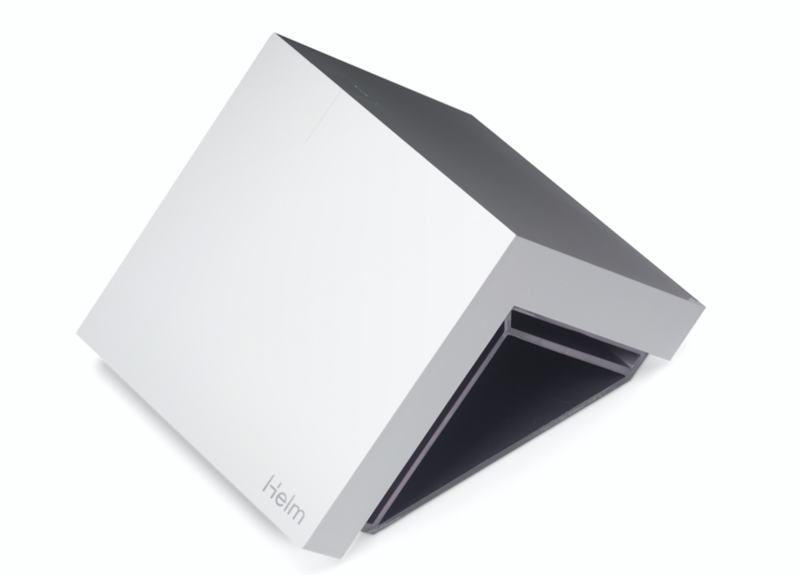你会弃用谷歌邮箱改用私人邮件服务器吗?看我的试用报告

|
我们能阻止大型科技公司随意掠夺我们的数据吗?尽管隐私权倡导者多年来一直大声疾呼,但立法界几乎没有对Facebook和谷歌采取什么管控,这些公司收集信息的行为如今愈演愈烈。但可能还有另外一种方式:与其等着隐私法跟上时代,消费者可以先启用能够保证个人数据安全的技术。 这是Helm的承诺,该公司承诺其设备可以取代谷歌Gmail邮箱和微软Hotmail邮箱等企业电邮服务,后者虽然免费却可以让这些公司访问你的邮件。相比之下,使用Helm,你可以运行自己的电子邮件服务器(是的,就像希拉里·克林顿一样),把电邮存储在家里。 我决定试一下,暂时用Helm的电子邮件代替两个Gmail账户中的一个(当然我承认,是不常用的那个)。我想看看自己是不是已经准备好为隐私权冒个险,完全接受一项让你和公司电邮供应商分手的服务。 |
Can we stop big tech companies from feasting on our data? Despite years of outcry from privacy advocates, lawmakers have done little to rein in Facebook and Google, which today suck up more information than ever. But there may be another way: Instead of waiting for a privacy laws to catch up with the times, consumers can turn to technologies that keep their personal data safe in the first place. That’s the promise of Helm, a device that offers an alternative to corporate email services like Gmail and Microsoft’s Hotmail, which are free but give the companies access to your messages. Helm, by contrast, lets you operate your own email server (yes, like Hillary Clinton) and store your emails in your own home. I decided to give it a try by trading in one of my two Gmail accounts (admittedly, the one I use less frequently), and temporarily replacing it with a Helm-based email instead. I wanted to see if I was ready to take the privacy plunge, and fully embrace a service that lets you divorce your corporate email provider. |

|
Helm个人服务器套装到货时装在一个小盒子里,安装也很容易。设备自重很轻,5英寸高,看起来很像宜家卖场出品。 虽然Helm服务器可以通过家里或办公室的无线网络联网,但我选择使用硬线连接的方式,通过附带的网线直接连上路由器。然后,我用蓝牙将其与手机配对,下载了Helm应用程序,上面弹出了一系列如何把电子邮件定向投递到该设备的操作说明。 这个过程分两步。首先,在Helm程序中输入服务器的名字和新电子邮件地址。(新电子邮件的后缀不是“@gmail”或“@hotmail”,而是基于你为服务器选择的域名。例如,我的新电邮地址可以是jeff@Fortunereporter.com,或者其他地址,随你选)。这样,我iPhone上的原生电子邮件应用程序现在就能接收发送到新邮箱的邮件了。 这个新邮箱完全绑定在你家里服务器的域上。因此,如果有人给你的新邮箱发送邮件,根本不会经过谷歌或微软的服务器。但是,另外一个问题是如何处理你现有的电邮,以及如何处理发到旧谷歌邮箱的邮件。这是这个过程的第二步。 这需要让Helm程序将我现有的Gmail邮件全部导入新的电子邮件账户。这一过程大约需要24小时,但能肯定的是,操作完成时,6651条邮件全部都移到我客厅的Helm服务器上了。 如果确定要和谷歌邮箱彻底分手,我可以删除谷歌邮箱账户中所有的邮件,设置转发服务,只要收到新邮件就转发,并通知我新邮箱的通讯人。但我还不那么确定——这只是一次试用,所以我让谷歌邮箱还保持了原样。最后,我在笔记本电脑上将新的Helm电子邮件地址添加到电子邮件客户端(我用的是Apple Mail),这样在电脑上也可以收邮件了。 要买吗? 那么结论是什么?首先,我喜欢Helm设备带来的控制感。使用Helm,我的私人邮件就存在客厅的服务器上,而不仅仅是远方某一台谷歌电脑上。我们对技术的体验往往是被动的,Helm的设备恰恰提醒了我们,不需要和科技巨头进行浮士德式的数据交易,也可以使用电子邮件等日常工具。我还应该把便签和日历等应用程序加到Helm设备上,这样就可以摆脱大公司的同类产品了。 Helm还有一个非常酷的功能,它可以添加多个电子邮件账户,这样如果家里人想设置自己的私人电子邮件也十分轻松。如果越来越多的人发现,选择保护自己的电邮隐私十分简单,还决定试一下能够保护隐私的网络浏览器和手机,不难想象会逐渐产生一种良性循环会。最后,Helm设备的安全性似乎非常有保证。我不是那种能弄明白服务器盖子下都是怎么运作的专家,但那些能弄明白的人——比如科技博客网站Ars Technica的专家——说Helm是安全的。 然而,虽然我十分欣赏Helm的理念,但近期我不会弃用谷歌邮箱账户(哪怕是那个备用邮箱)。一个原因是费用。Helm套装售价299美元,第二年起每年订购费是99美元。虽然相对于你得到的东西,这个价钱完全合理,但和免费使用相比,仍然是一大笔开销。 但更大的问题是不方便。Helm不允许通过浏览器访问电子邮箱,但这个习惯很难改。另外,谷歌邮箱拥有强大的搜索功能,操作方便360度无死角。当然,谷歌侵犯隐私权的行为多得我都不愿去想,最近一起侵权行为还涉及第三方访问谷歌邮箱,但这些都不会对我的日常生活产生直接影响。 总而言之,我喜欢Helm,而且相信它的使命(“隐私权是一种权利,而不是摆设”)十分崇高。但除非它能提供像谷歌邮箱一样方便好用的产品,否则可能很难将客户群扩大到核心客户——隐私权鹰派之外。与此同时,我们其他人只能寄希望于立法者能够共同行动,通过一部有意义的隐私法,也许这部法律能强制要求公司提供不掠夺客户数据的付费产品。(财富中文网) 译者:Agatha |
The Helm Personal Server review unit arrived in a small box, and the set up proved easy enough. The device itself is lightweight, 5 inches high, and looks like something you’d find at Ikea. Though the Helm server can connect to the internet via your home or office’s Wi-Fi network, I opted hard-wire it directly into my router using an included ethernet cable. Next, I paired the device to my phone using Bluetooth, and downloaded the Helm app, which prompted a series of instructions for directing email onto the device. This was actually a two-step process. First, you enter the server name and new email address into the Helm app. (Instead of “@gmail” or “@hotmail,” the new suffix of the new email will be based on the domain name you pick for the server. For instance, my new email could be “jeff@Fortunereporter.com”—or whatever). This meant my iPhone’s native email app was now configured to receive messages sent to the newly created email. This new email is tied entirely to a domain you select and that lives on the server in your house. So, if someone sends a message to your new email address, it won’t touch Google or Microsoft’s servers at all. But there’s also the question of what to do with all the email you have already, and what to do about messages sent to your old Gmail. That’s the second step of the process. This entailed asking the Helm app to import all of my existing Gmail messages into the new email account. This took about 24 hours to complete but, sure enough, by the time it was done, all 6,651 messages had been moved onto the Helm server in my living room. If I was confident that I wanted to break up with Gmail for good, I would then have deleted all the messages from my Gmail account, and set up a forwarding service that relayed any new messages and also informed my correspondents of my new email address. But I wasn’t that confident—this was just a trial—so I left my Gmail account as it was. Finally, I added the new Helm email address to the email client (Apple Mail in my case) on my laptop so I could receive incoming messages there as well. Should you buy it? So what was the verdict? First off, I liked the sense of control that came with the Helm device. It was empowering to realize my personal messages were sitting on a server right there in my living room, and not just on some far-flung Google computer. Our experience with technology is too often passive, and this was a good reminder you don’t need to cut a Faustian data bargain with Big Tech to use an everyday tool like email. I should add the Helm device also notes and calendar applications, meaning you could shed the corporate versions of those too. Another cool feature of the Helm is that one can add dozens of other email accounts, meaning it would be easy enough to set up family members with private emails of their own. It’s not hard to imagine a virtuous cycle taking off as more people discover an easy option for email privacy, and decide to also try privacy-focused web browsers and phones as well. Finally, the security of the Helm device appears to be pretty tight. I’m no expert in what goes on under the hood of servers, but those who are—such as the folks at Ars Technica—say Helm is secure. And yet. As much as I like the idea of the Helm, I will not be chucking my Gmail accounts (even my secondary one) anytime soon. One reason is cost. The Helm unit costs $299 plus an annual subscription $99 fee after the first year. The price feels entirely reasonable for what you’re getting but it’s still a big leap from free. But the bigger issue has to do with convenience. The Helm service doesn’t permit you to access email from a browser, which would be a hard habit to break. Then there is Gmail’s stupendous search features and its all around ease of use. Sure, Google has committed more privacy violations than I care to think about—including a recent one involving third parties having access to Gmail—but none of these have had a direct impact on my day to day life. The bottom line is I like Helm and believe its mission (“privacy is a right not a setting”) is a noble one. But unless the company can offer something as convenient as Gmail, it may have a hard time expanding its customer base outside of hard-core privacy hawks. Meanwhile, the rest of us are left hoping lawmakers get their act together to pass a meaningful privacy law—perhaps one that forces companies to offer paid versions of their products that don’t plunder our data. |













